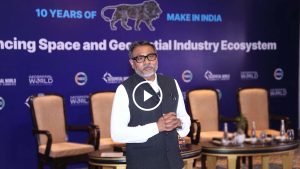In an exclusive interview with Geospatial World, Arpan Sahoo, Co-Founder and COO of KaleidEO, discusses the company’s mission to deploy India’s first high-resolution optical payload fleet, their partnership with ReOrbit to provide Earth Observation (EO) Infrastructure-as-a-Service, and simplifying the user experience with automated processes.
KaleidEO became the first private space tech company from India to achieve two key milestones, test edge computing in space and design and test a high-res optical, multispectral payload. Can you please tell us about this program and the results?
At KaleidEO, we aim to build upstream capabilities within the group. KaleidEO focuses on the upstream part of generating satellite imagery, while SatSure works on interpreting that imagery into analytics and software solutions. In 2021, we started an internal project to develop the payload, which is ultimately the heart of any satellite that generates images.
Our first step was to build a proof of concept, a prototype to demonstrate the technology, reduce development risks and iteratively improve the product. Our payload offers one-meter resolution and covers almost 65 kilometres of swath, 3x times higher than the market average of 15 to 20 kilometres. We partnered with European companies to build the prototype and assembled it in one of their laboratories, one of the tasks we have outsourced to the R&D ecosystem in that region.
Once the prototype was built, we tested it by mounting it on an aircraft to capture images of different geographies. With this, KaleidEO became the first private space tech company out of India to design, develop and test an EO, high-res, optical, multispectral payload in a maiden aerial flight. The results were great; we achieved high-res images on the first attempt. We are now at Technology Readiness Level 6 out of 9.
The next step is to launch it on a satellite & demonstrate it in space. Before this, KaleidEO became the first private space-tech company out of India to successfully test edge computing in space.
We have seen a huge amount of EO data influx which brings a need for increased analytical capability to turn that data into actionable insights. What is KaleidEO doing to aid EO data analytics?
The demand in the upstream segment should be driven by the need in the downstream sector, which is not usually the case. If the base of the pyramid isn’t strong, the top will collapse. We recognize the need for increased analytical capabilities to turn EO data into actionable insights.
SatSure, our parent company, has been building analytics and products for end users in the focus sectors like agriculture, climate impact, forestry, insurance, infrastructure, utilities and aviation since 2017. We, jointly, are shifting from creating bespoke solutions for each market segment to developing a standardized platform that multiple industries can use to build their own applications with remote sensing data.
This platform approach allows us to multiply demand by enabling more analytics companies and end users to grow using our platform. Our philosophy is to be an architect for the earth observation industry and enable more users to adopt satellite remote sensing technology.
KaleidEO focuses on developing analytics for strategic clients while SatSure does it for a broader ecosystem, many of which are new adopters of satellite remote sensing data and insights.
KaleidEO has been positioning itself in the EO Infrastructure-as-a-Service segment. Can you throw some light KaleidEO’s offerings?
The access to data insights from satellite imagery has become easier and the cost for owning, operating an asset and generating insights from it has reduced substantially over the last decade. What we have observed is that many end users, who are not spacesavvy but are clear about their data requirements, are looking to onboard vendors who can help them achieve their requirements.
Traditionally, they would need to coordinate with multiple stakeholders for sensors, satellites, ground stations, and data pipelines. This creates complexity. KaleidEO, having worked in Indian space missions, and with knowledge of building analytics, takes ownership in managing these multiple stakeholders, almost working as an architect, translating data requirements into hardware specifications, mission operations and data consumption infrastructure.
KaleidEO becomes a single point of contact for the entire project, and we at the backend manage everything for the client, through strong partnerships in the ecosystem. By offering as a Space infrastructure- as- a- service, we provide a one-stop solution, reducing the end user’s burden and ensuring reliable data delivery.
KaleidEO also signed a MoU with ReOrbit to develop full-stack solutions for the EO solutions. Can you please shed some light on this partnership and projects?
Our partnership with ReOrbit exemplifies how we are showcasing our capabilities as a leading architect in the Earth Observation (EO) ecosystem through our EO Infrastructure-as-a-Service.
With our single-window portal, users can task satellites, define regions of interest, and receive analytics seamlessly. For instance, if a user needs to count cars in a specific area, they can request this data from the satellite for a specified period through our portal, and the process will be automated from there.
Once the region of interest is defined, the map is uploaded into a mission planning tool, where data aggregated from other providers is already available. The satellite’s capacity is then verified and the task is scheduled accordingly. Our system handles everything from mission planning and satellite tasking to data collection and analytics extraction.
This integrated approach simplifies the user experience and offers various data delivery options, including satellite links. For time-sensitive tasks, we have edge computing on board the satellites for immediate analytics. Users can run models and get real-time data, such as the number of cars in an area, without needing to downlink the data, providing advanced capabilities within a single satellite.
Once the data is downlinked, it is processed in a cloud-hosted managed server, where automated pipelines generate the required analytics. This automated, integrated process enhances the user experience by ensuring quick, reliable data delivery. We plan to launch this system with ReOrbit by mid-2025.
What is the future roadmap for KaleidEO?
In the short term, we are continuing to develop disruptive payload technologies to cater to a wider market, particularly for civilian and commercial space in emerging, price-sensitive markets in developing countries.
Currently, the market for payload solutions is geared toward strategic users, but there is potential to provide affordable, high-quality data to unlock new use cases. Although there is a lot of data available today, it lacks the right quantity and quality needed for these new applications.
There is a need to develop strategic solutions for institutional users. We are offering our payload services and consultancy, edge computing capability and building an EO IaaS. In the long term, we are looking forward to partnering with companies and consortiums to build an ecosystem that makes access to EO data and insights easy and affordable for everyone.











